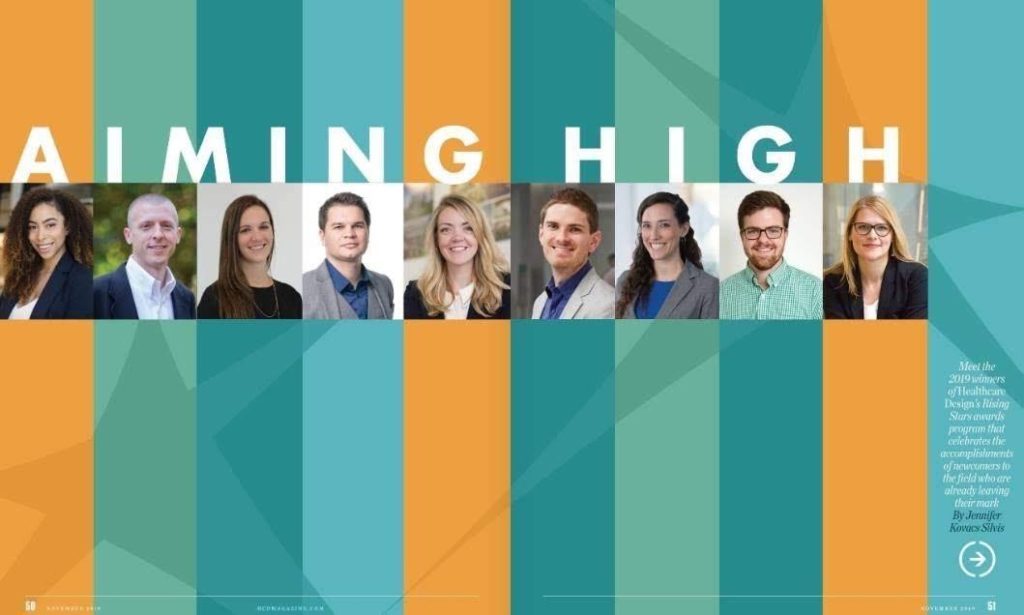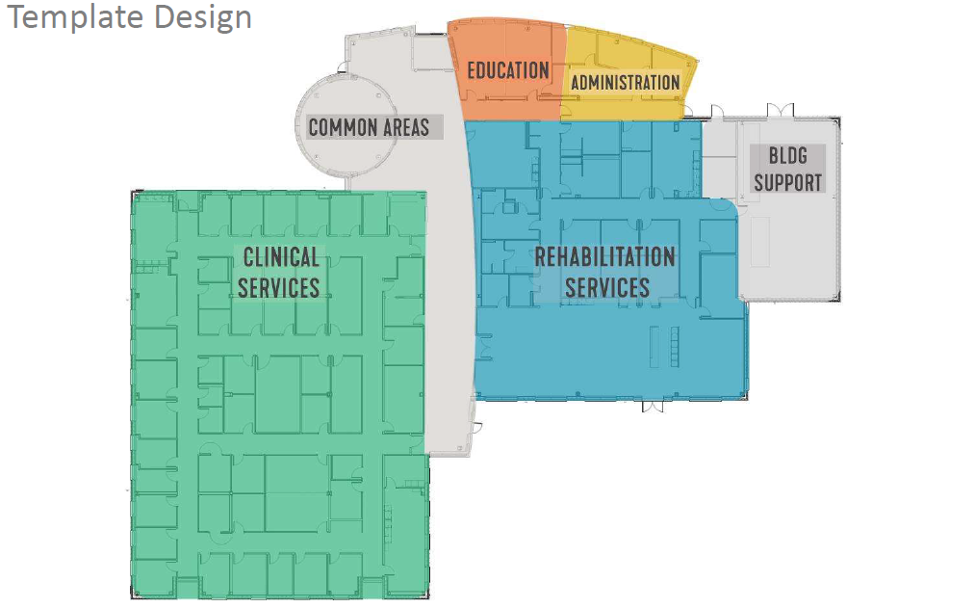HCD’19 saw behavioral health take center stage, and as the stigma of mental health fades away, the AEC industry is proving ready to take on the challenge of designing for humanity at its most vulnerable.
By Stephen Parker, AIA NCARB LEED AP BD+C,
Architect + Planner, SmithGroup
Editor’s Note:
Architect and planner Stephen Parker, AIA NCARB LEED AP BD+C, is based out of SmithGroup’s D.C. offices, specializing in healthcare with an emphasis in behavioral health design. As a community designer and advocate, Stephen writes about community-driven design topics & issues of impact in the AEC industry as part of the Hunter Douglas Architectural’s Young Architects Roundtable. Stephen previously served as the AIA’s Young Architects Forum National Advocacy Director & co-founder of the AIA’s National Design Services Act (NDSA) Coalition. He is a recipient of the 2018 AIA Young Architect Award, the 2019 HCD Rising Star Award & most recently, the AIAS Emerging Professional Honor Award. Parker was elected as an At-Large Representative to the AIA’s Strategic Council as its youngest architect, leading as a Class Representative and Co-Covener of the Mental Health + Architecture Incubator on the Council. Parker shares, in his own words, his experiences at last fall’s Healthcare Design Conference + Expo.
Last fall, thousands of healthcare designers, planners, architects, providers, and manufacturers inundated the Crescent City. Each year, the industry gathers to learn, network, and recognize excellence in the field during the annual Healthcare Design Conference + Expo, known simply as HCD, the industry’s largest gathering. As a 2019 HCD Rising Star Award Winner, I had the unique opportunity to visit this mecca of healthcare design and for a nerdy architect like me, dive in deep.
Among the 2019 Class of HCD Rising Stars, many of us hailed from the corporate giants or boutique specialty firms in the industry. From accomplished community designers working abroad to design researchers raising the standard of care for patients, each of us brought a unique perspective and drive to be impactful with our work, no matter our age.
Beyond the technical differences, a unique feature of the healthcare architecture is the passion many share, namely around designing for humanity at its most vulnerable. It’s this shared sense of purpose that brings everyone together, with each of us recognized for blazing the path forward early in their careers.
While each of us had a particular interest area, it seemed that many of us shared a passion for behavioral health. As the stigma of mental health fades away, the design industry is also directing more attention to this topic. As our shared social conscience persuades our clients and decision-makers to provide quality care to those with invisible wounds, it’s heartening to find designers taking on the challenge. This was reinforced with the numerous sessions on behavioral health design available at the conference, more than any conference I’ve ever seen.
There are numerous, specialized spaces where behavioral health patients are treated. Some are in outpatient facilities, others in crisis stabilization units for short stays, and others are treated in long-term within hospitals, all depending on how they present to a provider and their recommended duration of care. Most sessions concentrated on the design of inpatient or outpatient facilities, whether renovated or new construction. Each faced distinct challenges, but also pushed design to create something better.
EVOLUTION OF OUTPATIENT CARE
One session highlighting the National Intrepid Center of Excellence (NICoE), was especially unique. Originally built at the Walter Reed National Military Medical Center in Bethesda, MD, the NICoE is among the world’s most advanced treatment and research centers for traumatic brain injury (TBI) and psychological health. The first and largest NICoE is the hub for a system of satellite clinics around the country to treat service members struggling with persistent TBI symptoms and PTS. The satellites, or Intrepid Spirit Centers (ISCs), deploy with a prototype design that enables speed to market and adaptation to local programming needs. They function as a specialized healthcare system, establishing a core mission and protocols, and conducting synchronized multi-site research and physical design improvements to the rapidly evolving model of TBI care and rehabilitation. Invisible wounds can cut just as deep as physical ones, whether we acknowledge them or not.
NEW CONSTRUCTION, NEW INSIGHTS
At one point in US history, each state boasted an impressive mental health system, many based upon the famed Kirkbride hospital design. However, with the defunding of mental healthcare and subsequent deinstitutionalization in the 1980s, new construction has been less common. In recent years, with the change in the healthcare landscape and raising awareness of mental health in society at large, there have been a number of new facilities coming online. Two such facilities, MindSprings in Grand Junction, CO, and the NeuroDiagnosis Institute in Indianapolis, IN, are new, greenfield hospitals specializing in behavioral health.
Both projects sought to bring in natural light into patient spaces to create a more therapeutic environment. Accessing, but also controlling light is critical for patients. Many inpatient behavioral health facilities have integral blinds, but require a patient to ask a staff member to adjust them. Simple design decisions, such as a window blind that a patient can safely control themselves, can make a world of difference. The dignity of patients is just as important to recovery as any therapy and the built environment can positively reinforce that sense of dignity.
For MindSprings, a non-profit provider in Western Colorado, their outdated facility and existing patient population needed a better care environment. The ample courtyards, abundant natural light, and generous spaces provided a refreshing change from earlier, more institutional facilities. The presenting team shared a moving story of how a patient wept once they entered the new building, remarking on how grateful they were for such a beautiful new space. Everyone is deserving of great design, and that holds true for society’s silent and suffering.
REIMAGINING INPATIENT RENOVATIONS
Another session dived into a challenging rehab approach. With 1 in 68 children diagnosed on the spectrum, specialty health providers are seeking new ways to address the demand, particularly challenging cases. KVS Health in Kansas, acquired an old ambulatory surgical center to renovate into a small psychiatric hospital. As a non-profit, budget was a key constraint. The existing facility offered many challenges, namely its lack of a multipurpose space. For acute, psychiatric facilities, patients are in what is called a “locked” unit and the opportunities to exercise are often limited. Developing a large enough space with durable finish selections, offer the flexibility to transform a dining room into a therapy space or gymnasium. For the many youth and children treated in this facility, this was especially helpful in their healing process. Play is a form of therapy and we should design healing spaces to promote it.
For Maryvale Hospital in Maricopa County, Arizona, the design and construction team had less than a year to pull off a 200-bed renovation of an abandoned hospital. Besides the fast-paced deadline, the team was able to overcome significant challenges through close collaboration in the design and construction phases. This extended to the manufacturers as well. To ensure that the specialized, psych-safe windows with integrated blinds came to site on time, a rolling delivery schedule was necessary to meet the break-neck pace of the installation crews.
BUILT ENVIRONMENT AND BRAIN EVOLUTION
This emphasis on mental well-being and the impact of the built environment upon cognitive functions was reinforced with the keynote speaker, Dr. Eagleman. A neurosurgeon, scientist, and author, Dr. Eagleman conveyed the resilient nature of the human brain and its near-infinite capacity for repairing itself. This healing and evolution of the brain’s capacity are as much about medical approaches as it is about the habits we reinforce and the spaces we choose to dwell in. This was especially impactful for the designers of healthcare spaces as the built world can have a profound impact on how stress is managed and how fast a patient heals. Dr. Eagleman encouraged everyone to find ways to spur their own brain development by changing up their routine, enhancing their environment, and seeking new experiences.
During the Healthcare Design Conference, it was a thrilling, enriching experience to be among so many designers advocating for better environments for patients and staff alike. As a design advocate, the healthcare industry is a special passion of mine and defines my career. Many of my fellow Rising Star winners shared stories of caring for loved ones in stark, institutional settings and it reinforced their determination to design a better future. For those suffering from invisible wounds, the greater awareness of mental health across society and among our clients will hopefully bring more advocates into the design field.






